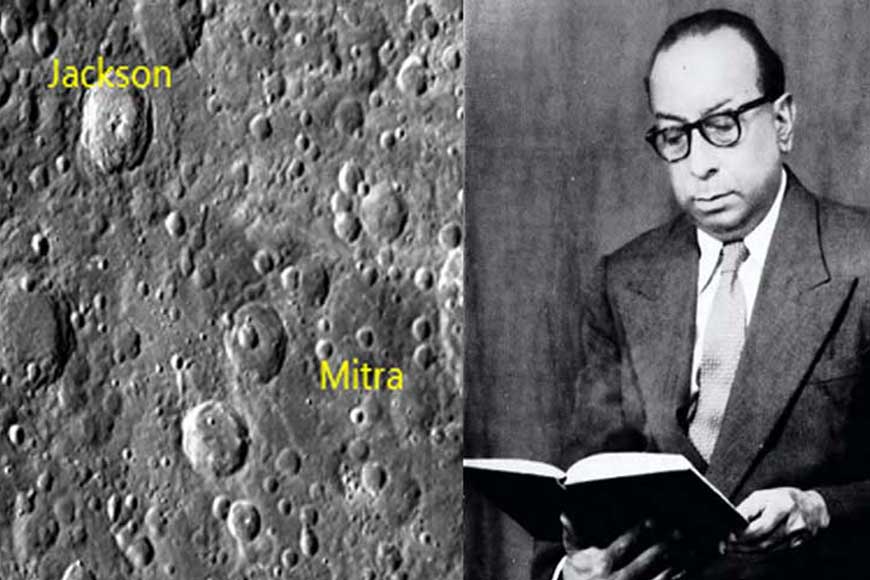Why is a moon’s crater named after illustrious Bengali scientist Sisir Kumar Mitra?

Remember India’s famous Chandrayan II mission last year to the south pole of the moon? The first ever attempt to land a robotic lander on the surface of the moon from the South Pole end. It was an ambitious project as that part is full of craters and rugged terrain and very few countries of the world had ever imagined to take that risk. Though the lander failed to make a soft landing, yet the orbiter kept sending images from the surface of the moon, specially those of impact craters, that helped scientists understand the terrain of the moon better.
Interestingly, the orbiter’s camera captured craters, one of which was named after a Bengali scientist and was known as Mitra crater. The Mitra crater with a 92-km diameter is named after famous Bengali scientist Sisir Kumar Mitra, who was the founder of ionospheric science and radio technology in India. Long-distance communication would be an unimaginable concept without Mitra’s notable work on ionosphere.
Born in Konnagar of Hooghly in 1890, Mitra received the Fellowship of Royal Society in 1958. He was the third son of Joy Krishna Mitra and Sarat Kumari. His father was a school-teacher and mother was a doctor in Lady Dufferin Hospital at Bhagalpur in Bihar. Sisir Mitra first went to school in Bhagalpur and showed a serious interest in scientific studies and spaceflight. Seven-year-old Sisir was inspired by Ram Chandra Chatterjee, an acrobat, parachutist and balloonist who was the first Indian aeronaut to do a solo flight on a hot air balloon. Chatterjee’s inspiring journey became the driving force for Mitra.
A few years later his two elder brothers died and father was paralysed, and he was almost on the verge of leaving school. But his mother insisted him to stay on. She was an outstanding woman, and came all out to support her son’s education and the family through her earnings from the hospital. After school, Mitra was admitted to T.N.J. College, Bhagalpur, and from there in 1908 to Presidency College, Calcutta. In 1912 he headed the list of successful candidates for the MSc degree in Physics and worked as a research scholar under legendary scientist Jagadish Chandra Bose. He was also writing for science magazines and looking for noteworthy research opportunities.
 Mitra was invited by Sir Ashutosh Mukherjee in 1916 to work as a post-graduate scholar under Nobel-prize winner CV Raman, working on ‘Interference of light and diffraction.’ After receiving his PhD from Calcutta University in 1919, he left for the University of Sorbonne in Paris in 1920 to explore the field of optics and spectroscopy. He worked with another Nobel winner Marie Curie, but shifted to Radiophysics as it fascinated him while working on his research project under Professor Camille Glutton. Mitra decided to dedicate his entire life to radio science. He returned to India, to his roots, and explained to the then Vice-chancellor of Calcutta University Sir Ashutosh Mukherjee, the need to establish wireless science as a field of study for post-graduate students. He convinced him and a new course was introduced. Around this time Mitra started his pioneering research in wireless communication by setting up a wireless laboratory in the Institute of Radio Physics and Electronics. A new instrument was built here, that was capable of measuring heights in various parts of the ionosphere, giving valuable insights about ionospheric conditions in subtropical regions.
Mitra was invited by Sir Ashutosh Mukherjee in 1916 to work as a post-graduate scholar under Nobel-prize winner CV Raman, working on ‘Interference of light and diffraction.’ After receiving his PhD from Calcutta University in 1919, he left for the University of Sorbonne in Paris in 1920 to explore the field of optics and spectroscopy. He worked with another Nobel winner Marie Curie, but shifted to Radiophysics as it fascinated him while working on his research project under Professor Camille Glutton. Mitra decided to dedicate his entire life to radio science. He returned to India, to his roots, and explained to the then Vice-chancellor of Calcutta University Sir Ashutosh Mukherjee, the need to establish wireless science as a field of study for post-graduate students. He convinced him and a new course was introduced. Around this time Mitra started his pioneering research in wireless communication by setting up a wireless laboratory in the Institute of Radio Physics and Electronics. A new instrument was built here, that was capable of measuring heights in various parts of the ionosphere, giving valuable insights about ionospheric conditions in subtropical regions.
In 1926, Sisir Kumar Mitra could successfully transmit radio programmes from his laboratory at the University College of Science, Calcutta. This was the first time that an amateur radio station was broadcasting regular programmes in India. His book, Upper Atmosphere published in 1948 is considered the greatest reference for research in the field of ionosphere. Several advancements in the field of Ionospheric Science and Radio Technology in India would not have been possible without him. He was elected as the Fellow of the Royal Society in 1958 and he received the prestigious Padma Bhushan in 1962.
Even today his dreams continue as Indian students work in the field of ionosphere study. The Centre for Research in Space Environment of Calcutta University is aptly named after this great Bengali scientist.









